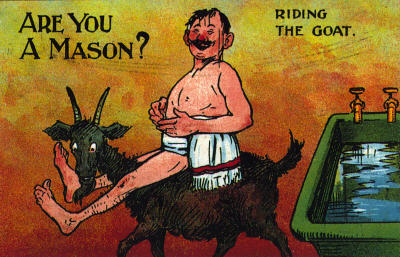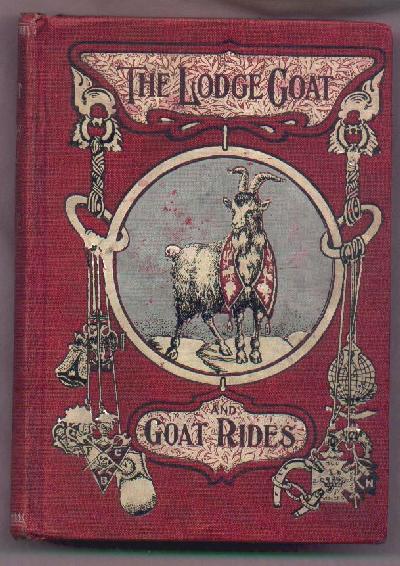
MasonicInfo Note: Much of this page derives from a work titled "LIBER CAPRICORNUS - THE SYMBOLISM OF THE GOAT" by Eugene W. Plawiuk as presented to Norwood Lodge #90, AF&AM, G.R.A. on September 3, 1991 and found among the files of 'Hiram's Chamber', likely the first widely-used Masonic Bulletin Boards and shepherded for many years by Preston Burner to whom Masonry on-line owes a huge debt of gratitude.
Whether it's as a recipient (i.e., in preparation for receiving the first degree of Freemasonry) or as a perpetrator, rarely does one fail to hear mention of "The Goat". It was - unfortunately - sometimes the first warning heard prior to entering the lodge as an Apprentice and - regretfully - it's a tool of anti-Masons in order to cast aspersions.

The origin of this ostensibly humorous initiatory jest is unclear and there doesn't seem to be anyone who can cite its beginning. It might have come from the practical joker and Freemason but that's speculation at best. There are no references to it in the major Masonic reference works although some anti-Masonic works have used it as a source of derision for years. Further, it was common to joke about such a thing with initiation into other fraternal organizations as well, particularly groups like the Odd Fellows and the Knights of Pythias (you can see from the K of P Emblem in the lower left corner of the book at the bottom of this page - and the goat pictured is wearing what appears to be an Odd Fellows' collar!).
Because of the lack of references, it would be easy to dismiss our Goat as a simple joke, one which survived from the concept of fraternity hazing, once so popular. Thus dismissed, though, gives anti-Masons an ostensible charge with which to claim the demonic nature of Freemasonry.
The Goat dates back to the very earliest primordial memories of Man and has played a great role in the myths and legends of all religions and cultures of Western Europe.
 We learn of The Goat through the ancient science of Astrology first
developed by the Chaldeans, or as they are commonly known; Babylonians. Brother Plawiuk
says, "The Goat symbolizes male fertility, and is known, to even those who peruse the
daily astrology columns of the local newspaper, as representing the astrological sign of
Capricorn; Dec. 22 to January 22. Capricorn is a combination of both a Goat and and a
fish. According to J.E. Cirlot in his Dictionary of Symbols, this dual aspect refers to
'the dual tendencies of life towards the abyss (or water)' or chaos of the beginning of
time, and 'the heights of mountains' or order and malkuth (the earth) as symbolized by the
goat aspect."
We learn of The Goat through the ancient science of Astrology first
developed by the Chaldeans, or as they are commonly known; Babylonians. Brother Plawiuk
says, "The Goat symbolizes male fertility, and is known, to even those who peruse the
daily astrology columns of the local newspaper, as representing the astrological sign of
Capricorn; Dec. 22 to January 22. Capricorn is a combination of both a Goat and and a
fish. According to J.E. Cirlot in his Dictionary of Symbols, this dual aspect refers to
'the dual tendencies of life towards the abyss (or water)' or chaos of the beginning of
time, and 'the heights of mountains' or order and malkuth (the earth) as symbolized by the
goat aspect."
Continuing, Plawiuk says:
In fact the very same Babylonians who gave us this symbol of Capricorn and the science of Astrology were the first Temple builders, and the goat for them symbolized the essence of the Temple or Lodge. An animal usually found climbing in the mountains. Thus from the first ziggurats to the Temple of Solomon even to later Churches the Goat was seen as symbol of Man striving to reach God through his building of Temples that represented mountains. Since in all religions Gods abode is symbolized by mountains.
According to a research monograph on the Dionysian Artificers and Early Masonry edited by Manly P. Hall, the symbolism of the goat relates to the prechristian God Pan, Dionysius. The Goat-God was accepted by the later Greek Mystery Schools as the symbol of the Temple Builders. In fact the Dionysian Artificers was such a mystery school. They viewed practical Temple Construction as a source of understanding the mystery of Nature and God...
Besides representing the Temple or Home of the gods, the goat represents the active male sexual or fertility aspect of nature. As Capricorn he rules the returning sun, from the darkness of winter solstice. In the sign of the Goat/Capricorn the sun begins to resume its ascent towards the spring Equinox. As well the goat horn is a hallow phallic symbol, represented even today as the cup of plenty or cornucopia which we see represented in the Lodge.
Says J. E. Cirlot; " In mythology it was the goat Almathea who fed the infant Jupiter an milk. Given that the general symbolism of the horn is strength, and that the goat has maternal implications, and in addition that the shape of the horn (phallic outside and hollow inside) endows it with complex symbolism (including that of the lingam or symbol of generation) it is easy to understand its allegorical use as the horn of abundance. Plobb points out also that the cornucopia is an expression of prosperity deriving from its association with the Zodiacal sign of Capricorn."
The androgynous symbolism of the horn of plenty is typical of the symbolism of the goat in general. While the Greek Goat Gods Pan and Dionysius were male, we look at the goat as an animal in masculine terms while it is both male and female. The identification of the the male goat in by his beard, since both genders have horns. The phrase " by my beard, or " he pulled my beard " as well as the style of beard called a 'goatee' all relate to the goat.
The goat-Gods Pan and Dionysius in Greek mythology represent the forest and unbridled nature; lust in the case of Pan and Drinking, and fertility in the case of Dionysius. Hence from the OED we have the term for a lecherous older man; "you old Goat". Pan is represented as being half human, half goat with horns, and would later be used in medieval times to represent the devil.
Ironically the horns on the head of Michalangelo's statue of Moses are also Goat horns, symbolizing not the devil but the power of nature and natures God; Fiat Lux. For in the Bible it states that Moses was beheld by his people as having two rays of Light springing forth from his head.
"Hark! My Beloved! here he comes, bounding over the mountains, leaping over the hills. My beloved is like a gazelle or a young wild goat." "My beloved is mine and I am his; he delights in the lilies. While the day is cool and shadows are dispersing, turn my beloved, and show yourself a gazelle or a young wild goat on the hills where cinnamon grows." " How beautiful you are my dearest, how beautiful! Your eyes behind your veil are like doves, your hair like a flock of goats streaming down Mount Gilead."
The Song of Songs (Which is Solomon's). Herein as well in the Old Testament we find the beautiful love poem which views the goat as symbolizing nature, and fertility as it did in prechristian times. In the Song of Songs both lovers refer to each other as goats. As to be expected since the lovers in this poem are a shepherd and shepherdess herding goats!!! And we have the symbolism of the goats in relationship to sacred mountains or temples. It is enough to mention that this song is known as Solomons who plays such an important role in Freemasonry.
In medieval times clerical knights and military orders made up of priests during the crusades differentiated themselves from regular knights by riding upon goats rather than horses. This tradition can be seen in the Knights Templar who would ride horses but two knights to one horse, thus representing their clerical origins.
As I mentioned earlier the Boat and the Goat-God Pan became equated with the devil in medieval Christianity. But to medieval occultists especially Rosicrucians the goat symbolized the elemental energies of the earth, the sign of Saturn and the alchemical element derived therefrom.
In the Tarot it is the Major Arcana card #15 the Devil, who shows a goat headed deity with a man and women chained to him. The symbolism is that of people who strive for material rather than spiritual gain.
The Goat of Mendes or Baphomet whom the Templars were accused of worshipping is a Goat Headed deity, being formed of both male and female principles, with a Caduceus of Mercury for its phallus. One arm points up and one down , with the Latin ' Solve et Coagula' written on them. This is not the Christian devil but a symbol of the ancient alchemists representing the fact that nature and natures God is a combination and balance of male and female forces, light and darkness, moisture and dryness. The very principle of Hermes Trismegitus; As Above So Below" is what is symbolized by Baphomet.
Another Goat headed deity worship by the ancient pagan Celtic peoples was Cernnunos the horned god of the Wood. Today in witchcraft covens the goat head is seen to symbolize this ancient deity.
Unfortunately to the those who remain in the dark, these goat deities are seen as something evil rather than as the symbol of the earth, fertility, the prima mater, and the first principle.
Freemasonry in its past like its predecessor the Knights Templar have been accused of being in league with the Devil, being a satanic tool etc. That has arisen from the fact that FreeMasons by their initiation into the Light have been eager to research and study the Mystical symbols of the past and present, without fear or irrational prejudice. In times past of religious persecution and superstition the Mystical Mason has treaded the path of heresy in search of the Light of Truth.
I hope that this paper has afforded us all a broader view of meaning and depth of the symbolism of even something as simple as "our little joke", about the Goat.
BIBLIOGRAPHY
WEATHERVANE BOOKS 1978
J.E.CIRLOT: A DICTIONARY OF SYMBOLS. PHILOSOPHICAL LIBRARY NY 1971.
DR.R. SWINBURNE CLYMER: ANCIENT MYSTIC ORIENTAL_MASONRY.
THE ROSICRUCIANS: THEIR TEACHINGS: THE PHILOSOPHY OF FIRE
PHILOSOPHICAL PUB. PA. 1907 REPRINTED BY HEALTH RESEARCH, CA.1969
ALEISTER CROWLEY: 777. WEISER PUBLISHING 1978
MALCOLM C. DUNCAN: DUNCANS RITUAL OF MASONRY. DAVID MACKAY CO.
WESLEY J. FUERST: CAMBRIDGE BIBLE COMMENTARY: THE FIVE SCROLLS
COMMENTARY ON THE SONG OF SONGS. CAMBRIDGE UNIV. PRESS 1975
DAVID-GODWIN: CABALISIIC ENCYCLOPEDIA LLEWELLYN PUB.1979
MANLY P. HALL: ed, THE DIONYSIAN MYSTERIES AND MASONRY. PHILOSOPHICAL PUB. HOUSE 1936.
WALTON HANNAH: CHRISTIAN BY DEGREE. BRITONS PUB. CO. 1964
|
Related Topics: |
|
In addition, |
